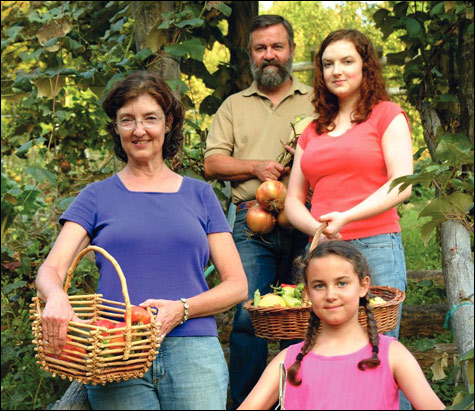
FREE-RANGE: Kingsolver combines exposé, personal testimonial, and how-to. |
| Animal, Vegetable, Miracle: A Year of Food Life | By Barbara Kingsolver, With Steven L. Hopp and Camille Kingsolver | Harper Collins | 384 pages | $26.95 |
In 2005, author Barbara Kingsolver moved her family from Tucson to a farm in Virginia to embark on a year-long experiment of returning to nature. Through an entire cycle of seasons, the family would grow their own food; what Kingsolver, her husband, and their two daughters couldn’t grow, they’d obtain from local sources — food grown “so close to home . . . that we’d know the person who grew it.” (They allowed themselves a few exceptions, such as coffee, olive oil, and dried fruit.) Animal, Vegetable, Miracle is the story of that year.
It’s also the tale of America’s food culture, or lack thereof. Instead of valuing foods as they come into season, and enjoying each month for what it might bring to our plates, we’ve developed what Kingsolver calls a “supermarket culture,” in which out-of-season fruits and vegetables are — unnaturally — available year-round. We suffer for it, she says, when we eat tomatoes in winter “that taste like slightly sour water with a mealy texture.” Think of AVM (as enviro-blogs are calling it) as a mix of Eric Schlosser’s true-story-of-Happy-Meals, Fast Food Nation (only not as preachy), Morgan Spurlock’s eat-at-McDonald’s-for-a-month Supersize Me (except less sensationalistic), and any Martha Stewart magazine (but not as annoying). In other words, a combination of exposé, personal testimonial, and how-to. As she moves chronologically through the year, Kingsolver uses the micro stories of her farm to introduce such macro issues as raising livestock and buying local. This approach renders her sweeping experiment more bite-sized and manageable.
Throughout, husband Steven — a biology professor — provides sidebars on everything from national farm politics to fair trade, and older daughter Camille — who leaves halfway through the experiment for Duke University — offers a 19-year-old’s perspective as well as enticing recipes. And Kingsolver’s vignettes about eight-year-old Lucy’s egg-selling business are charming.
Sure, the author can come off as smug — would it be possible to accomplish all that she did without feeling self-satisfied? But she adds enough straightforward storytelling and amusing anecdotes (turkey matchmaking!?) to ensure that the book isn’t as sanctimonious as many I-did-it accounts can be. Her description of just-picked asparagus made me want to forgo the vegetable for 10 months so I can appreciate the fresh version when it’s in season. Her treatise on canning tomatoes was so inspirational, I stopped reading the book to purchase a home-canning kit. And her discussion of free-range livestock versus the horrors of concentrated animal-feeding operations offers one of the more sensible defenses of — and most balanced approaches to — carnivorism.
Of course, we don’t all have a spouse who owns a 40-acre farm in southern Appalachia that comes complete with a barn, orchards, and morel mushrooms growing on the hillside — many of us are lucky to have a few feet of sunny porch space. Kingsolver knows this, but she’s not letting us off the hook. “Small, stepwise changes in personal habits aren’t trivial. Ultimately they will, or won’t, add up to having been the thing that mattered.”